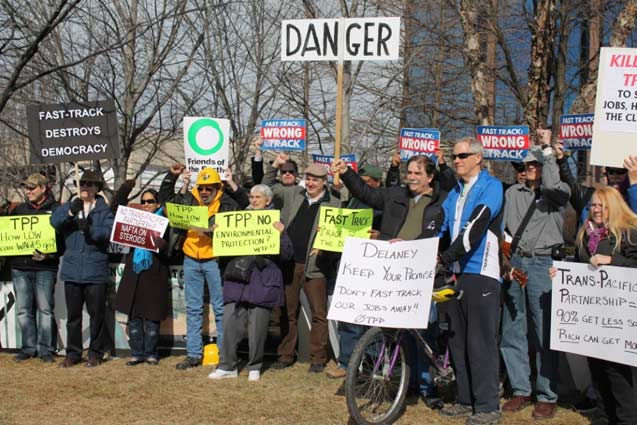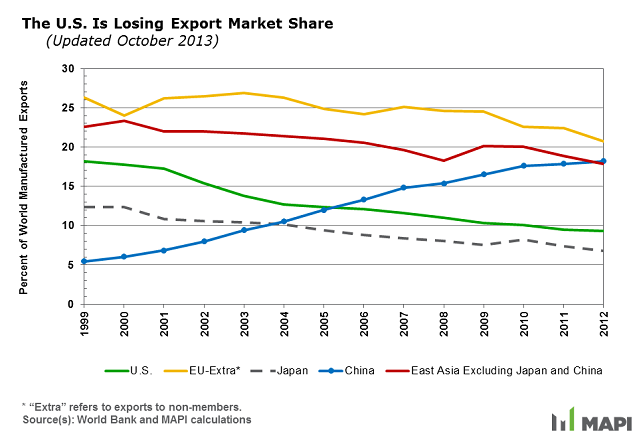
The TPP represents not “freer” trade, but re-regulation of trade to entrench corporate profit making. Economist John Weeks skewers the free trade dogma that is the ideological justification and corporate sales pitch for neoliberal globalization.
The gathering pressure for Congress to “fast track” the Trans-Pacific Partnership (TPP) demonstrates yet again that trade liberalization is one of the few aspects of economic policy about which there is agreement across the mainstream of the political spectrum, in both the United States and Europe. Almost all conservative commentators endorse it with gusto, for centrists it is an article of faith, and even many progressives accept it implicitly by their criticism of industrial country protection.
The neoliberal ideologues sell it by bestowing the label “free trade,” which is allegedly reached by repeated measures of “trade liberalization.” No matter that the TPP has little to do with trade and everything to do with setting loose capital on a global scale. Well tested and demonstrably disastrous in the North American Free Trade Association, this liberating of capital includes 1) global extension of corporate patents under the moniker “intellectual property rights,” 2) shifting enforcement of those patents from national governments and courts to ad hoc international tribunals, and 3) prohibiting as “protectionist” measures protecting labor rights and the environment.
This is not “freer” trade, but re-regulation of trade to entrench corporate profit making. However, if you call it freer trade, you can sell it to the public. In order to discredit this corporate sales pitch, I have to drive a stake through the heart of the Free Trade dogma that is the ideological justification for neoliberal globalization.
The greatest economist of the 20th century, J M Keynes, explicitly recanted his support for free trade. In a rarely quoted (suppressed?) passage in The General Theory, he wrote:
So lately as 1923, as a faithful pupil of the classical school who did not at that time doubt what he had been taught and entertained on this matter no reserves at all, I wrote: “If there is one thing that Protection can not do, it is to cure Unemployment. . . . So absolutely overwhelming and complete has been the domination of the classical [free trade] school. (The General Theory of Employment, Interest and Money, 1936, Ch 23, Section 1).
The disgust of Keynes over free-trade ideology did nothing to weaken the commitment of economists to this pernicious propaganda. The putative advantages of liberalizing trade are as well-known as they are bogus. It will increase welfare though a better allocation of production and consumption in every country (specialize in what you do best). It will increase domestic competition and lower prices for consumers. And it will stimulate exports and employment as the mirror of the cheaper imports. Better use of resources, cheaper goods and more employment. What’s to be against?
The simple answer is, as I show in my new book, Economics of the 1% : Everything. Jagdish Bhagwati, today’s leading advocate of “free trade” and winner of the Nobel Prize in economics, demonstrated 50 years ago that the assumptions required to conclude that free trade improves human welfare are absurdly restrictive and – he should have written – an insult to the intelligence. They include 1) continuous full employment of all resources in all countries; 2) all countries can produce all traded commodities; 3) the consumption patterns of people of all countries are the same; and 4) in every country, the same technology is used to produce each commodity. (The true believer in free trade might wish to read the Jagdish Bhagwati 1964 article, “The Pure Theory of International Trade,” Economic Journal, 74, 1-78).
Accept these absurdities and the most that can be demonstrated is that some trade is better than no trade (autarky in the economics lingo). It cannot be demonstrated that more liberalization is an improvement on less. This inability to generalize about the consequence of reducing protection measures goes by the oxymoronic name “Principle of the Second Best.” The point is simple: Some policy measures may exist to protect the population against fraud, deception and market power of global corporations. Removing one of these while leaving others in place may facilitate those maladies.
Second – and contrary to oft-repeated assertions – in practice, protection (tariffs and quotas) rarely reduces competition from foreign suppliers. If effective, tariffs and non-tariff measures increase the prices at which imports sell. This does not prevent competition from being intense in the protected domestic market. As part of an industrial policy, trade protection can be designed to foster competition, as in South Korea over the last four decades. And, of course, it is quite common in small countries for the allegedly competing imports to be marketed by the domestic producers of the same product (who have production facilities abroad). When this is the case, removing protection increases the profits of the monopoly importers.
Third, there is no theoretical basis for the argument that freer trade stimulates domestic production and employment. It is quite impossible to produce such a theoretical conclusion, because as I wrote above, trade models assume full employment. Adam Smith made the argument that trade provided a demand outlet for a country’s surplus production (“vent for surplus”) and thus could increase domestic employment. Subsequent economists rejected this sensible idea as naïve and simplistic.
As well they would. If domestic demand were insufficient for full employment, increased public expenditure or private domestic investment would resolve the problem as well as export demand would. The exception would be if a country requires a demand stimulus when it simultaneously suffers from an unsustainable import level. However, by letting in more imports, trade liberalization makes that problem worse, not better, as many African countries discovered in the 1990s under World Bank “adjustment” programs.
Always lurking in the free-trade wings is the argument that developing countries benefit from the elimination of industrial country protection, especially on agricultural products. Perhaps the most surprising thing about this argument is that anyone other than a true believer in free trade would take it seriously.
Most agricultural products protected by rich countries are not grown in the poor countries. The benefiting countries could be middle income (e.g., Argentina), where the agricultural population (and, therefore, number of beneficiaries) is small. Second, for those few products that are produced by low-income countries (cotton in Mauritania is invariably cited), the most likely beneficiary of a production decline in the United States and the European Union would be China, not a poor country in sub-Saharan Africa.
In addition, domestic processing and consumption of these products while diversifying exports might be a considerably better outcome than mutual trade liberalization. Better that Mauritania gins its cotton to make thread to clothe its population, than export it and import the clothes from China, the United States and Europe. Trade liberalization in exchange for access to foreign markets has been the death blow to industrialization strategies in many, if not most, poor countries.
As for trade in manufactures, the chart below shows the overwhelming beneficiary of increased access to developed country markets will be Chinese capital and global capital with production facilities in China. From about 5 percent of global manufacturing exports in 1999, Chinese companies in 2012 accounted for just over 20 percent. A recent report by the Economic Commission for Latin America and the Caribbean demonstrates Chinese high-jacking of Mexico’s trade in manufactures with the United States (complete report here).

(Manufacturing Institute, using World Bank statistics.)
I recently spent time in Bangkok and Hanoi working with the United Nations Economic and Social Commission for Asia and the Pacific. While hesitant to criticize the TPP because of US influence in the United Nations, ESCAP professionals showed a singular lack of support for it. The only enthusiasm I encountered for the TPP was in Hanoi, where the government actively pursues a mercantilist trade policy based on factory conditions and environmental degradation as bad or worse than in China. Working conditions in export factories in and around Ho Chi Minh City reinforce the image of globalized production as paying poverty wages in appalling working conditions (see the recent photo-report on Colombia in Truthout by David Bacon).
Consider a world in which all the major countries in 2008 responded to the global financial collapse with strong fiscal stimulus packages accompanied by temporary import and capital controls to prevent economic growth from generating unsustainable trade deficits. As these countries approached full potential by expanding domestic demand with steady exchange rates, even with the import restrictions, world trade would have grown faster than was actually the case. The measured growth of trade was an anemic 3.3 percent in 2008, a disastrous minus 10 percent in 2009, and a barely-breathing one percent during 2010. The recovery to 5 percent in 2011 fell far below the average for 1980-2007, dropped to a pathetic 2 percent in 2012, and about the same in 2013.
There is a lesson here. A world with free trade should come after – not before – global full employment and after strict national regulations on global capital. And a world with the corporation-liberating TPP should not come at all, ever.
Join us in defending the truth before it’s too late
The future of independent journalism is uncertain, and the consequences of losing it are too grave to ignore. To ensure Truthout remains safe, strong, and free, we need to raise $46,000 in the next 7 days. Every dollar raised goes directly toward the costs of producing news you can trust.
Please give what you can — because by supporting us with a tax-deductible donation, you’re not just preserving a source of news, you’re helping to safeguard what’s left of our democracy.